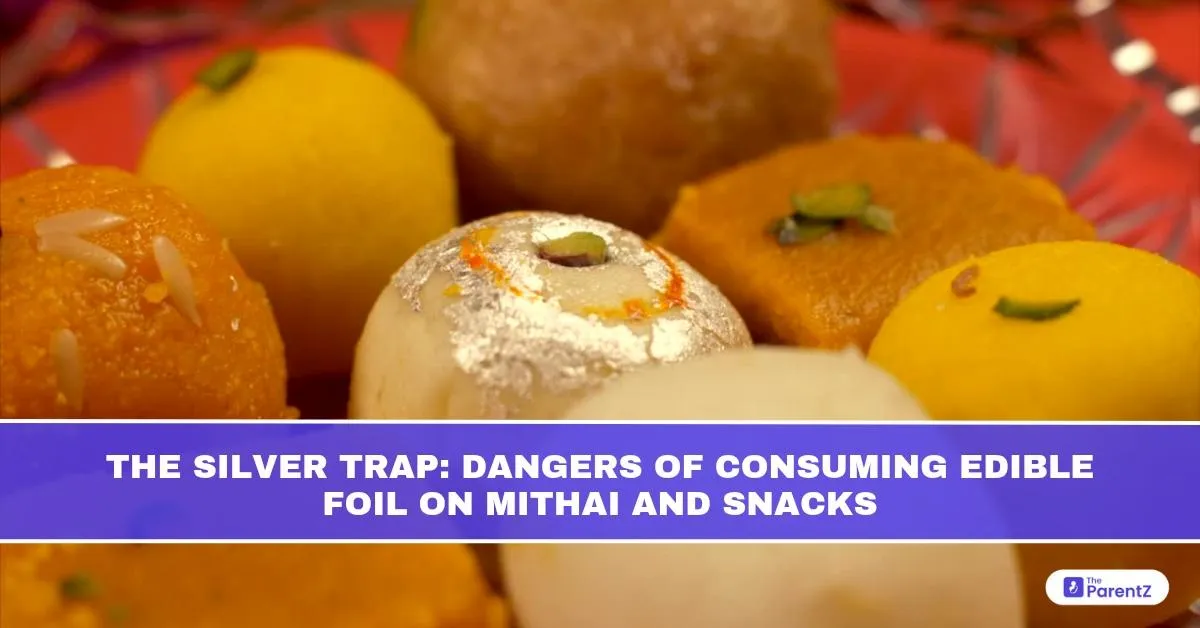A Shiny Tradition With a Hidden Side
Diwali lights twinkled across balconies, laughter echoed through the hallways, and plates of kaju katli and gulab jamun were passed around, each topped with a delicate shimmer of silver foil. In homes across India, silver-coated sweets symbolise luxury, celebration, and cultural pride. For children, the sparkling layer is part of the magic. It looks beautiful, tastes sweet (or so they think), and is eaten without question. But beneath this shiny surface lies a layer of concern.
Is that foil really silver? And even if it is it safe to eat?
Many parents are now beginning to wonder: could something so traditional pose a hidden risk to growing bodies?
What Exactly Is Edible Silver Foil?
Known as vark, this paper-thin foil is traditionally made by pounding pure silver into sheets so fine they can disintegrate on the tongue. In Ayurveda and Unani systems of medicine, silver has been used in trace amounts for centuries for its antibacterial and cooling properties.
When made correctly, pure silver foil is considered safe in very small quantities and even holds some therapeutic value. However, the issue lies not in the silver itself but in how it’s made, handled, and used today.
When Silver Foil Becomes a Risk
1. Purity Concerns
Not all that glitters is safe. In cheaper or mass-produced sweets, the foil may not be pure silver. It could contain:
- Aluminium: Cheaper and easier to use, but potentially toxic when ingested in large amounts
- Nickel or lead: Found in imitation foils or in cases of cross-contamination
- Silver alloys, which may not be food-grade
According to the Journal of Food Protection, unregulated edible foils sold in local markets were found to contain up to 30% non-silver metals, especially in unbranded or street-sold snacks.
2. Unsafe Manufacturing Methods
Traditionally, vark was made by placing silver between leather pouches (often of animal origin) and pounding it into thin sheets. Today, in some areas, low-cost processes still use unsanitary, outdated methods, raising the risk of:
- Microbial contamination
- Residues from animal skin or unclean equipment
- Lack of food safety regulation
In a 2016 investigation cited by the FSSAI, some manufacturers were found using aluminium in place of silver and storing foil in non-sterile conditions, leading to contamination of sweets.
3. Potential Effects on Children
Children’s bodies are more sensitive to contaminants. While minute traces of pure silver are generally excreted without harm, prolonged or repeated ingestion of impure foil can:
- Irritate the digestive tract
- Strain developing kidneys and liver
- Impact nutrient absorption due to metal interference
Pediatric toxicology reports have linked heavy metal exposure in early childhood with long-term effects on neurodevelopment, though only at high or chronic doses. Still, the precautionary principle applies particularly for very young children.
Understanding the Cultural Context
Despite these risks, it’s important to acknowledge that silver foil has deep cultural significance. In Indian households, serving sweets topped with vark is associated with prosperity, purity, and celebration.
So rather than reject the tradition altogether, families can be empowered to make safer, smarter choices. After all, preserving culture and protecting health can go hand in hand.
How to Identify Safe Edible Foil
- Look for FSSAI Approval: Always choose sweets from brands that follow proper food safety guidelines and display certifications. Reputable shops usually use certified food-grade silver.
- Check the Colour and Texture: Authentic vark has a delicate, almost see-through finish and disintegrates on the tongue. If the foil looks thick, shiny like gift wrap, or leaves a metallic taste, it may be aluminium or mixed metal.
- Ask Before You Buy: When buying from sweet shops, don’t hesitate to ask if the foil is pure silver. Most good establishments will know and be transparent.
- Choose Foil-Free for Kids: For toddlers and preschoolers, it’s better to scrape off the foil or choose sweets without it. This is especially important when the source or quality is uncertain.
- Make Mithai at Home: Homemade sweets are a wonderful way to control ingredients, hygiene, and presentation. If foil is used, ensure it’s packaged and labeled food-grade silver from a reliable source.
Silver Foil vs. Health: What Do Experts Say?
- The Indian Council of Medical Research (ICMR) notes that trace consumption of silver from traditional sweets is not harmful, provided the metal is pure and the amount is small.
- The World Health Organisation (WHO) classifies silver as non-toxic when consumed in very low quantities, but caution is advised with repeated exposure, especially in children.
- A study published in the Asian Journal of Pediatric Practice recommends limiting unnecessary exposure to non-nutritive metals in children’s diets, emphasizing hygiene and sourcing.
The Bright Side: Culture, Carefully Preserved
It’s easy to worry about every shiny thing a child eats, and rightly so. But with the right information, families don’t need to choose between tradition and safety.
- Sweets can still be shared and celebrated even without foil.
- Conversations about food safety can start early, teaching children the value of mindful eating.
- Celebrating festivals at home with foil-free or safely-sourced mithai becomes a wonderful family ritual.
In fact, many Indian chefs and food innovators are now offering foil-free gourmet sweets, using natural decorations like rose petals, pistachio dust, or saffron strands, all safe, edible, and beautiful.
Conclusion: Shine Without the Risk
Silver foil on sweets may be wrapped in beauty and tradition, but when misused or poorly manufactured, it can carry invisible risks, especially for children. Thankfully, the solution isn’t to abandon this cherished custom, but to approach it with care, awareness, and trust in reliable sources. With the right choices, Indian families can continue to pass on festive joy and not hidden toxins to the next generation. Let our celebrations sparkle, not our concerns.








Be the first one to comment on this story.